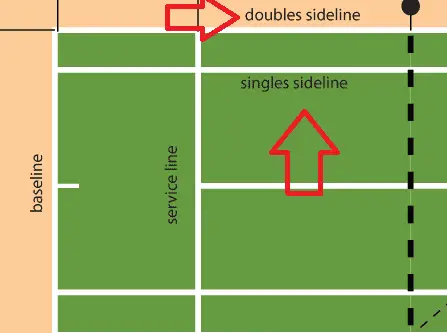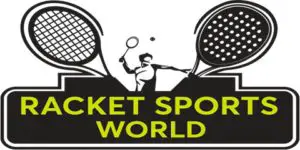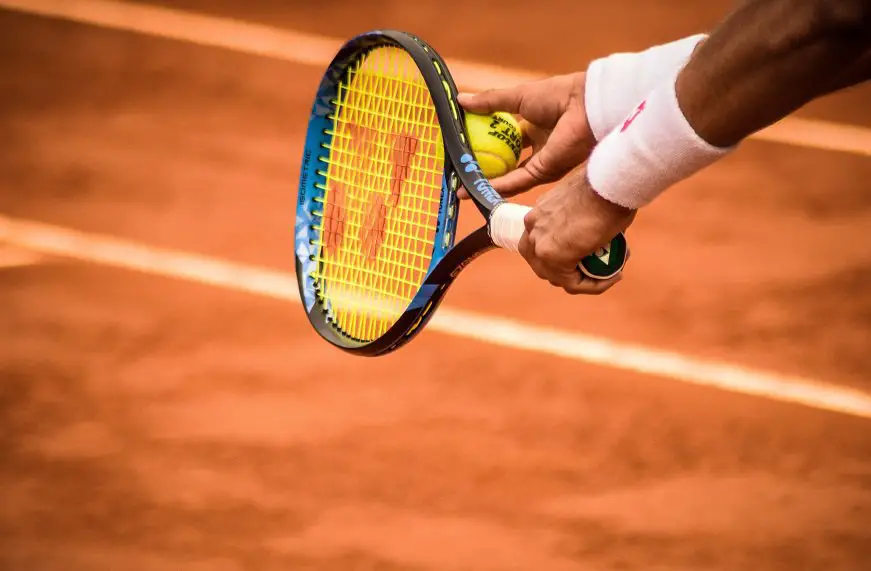One of the hardest shots to master in tennis is the serve. So many points can be won off of the serve (think about the top champion tennis players and the speeds of their serve) and a good serve can definitely be THAT SHOT that enables you to win matches. In the passages below we look at the various rules associated with a tennis serve and everything legal and illegal about it.
There are some very basis rules to the tennis service, and we are going to share them with you, together with our tips on what can make a really great serve, or service, as it is also known.
The rules of the tennis serve are actually a lot easier to learn than the serve itself. Here you go then.
Table of Content
The Basics of a Tennis Serve
Tennis serves are overhand, and they are diagonal. For each point, the server has two attempts at the serve.
If the first serve lands in the service court, that is the ball that’s played. If the first serve lands outside of the service court or goes into the net, it is a fault and the server has a second serve.
If this second attempted lands in, the ball is played. If the ball lands out, it is called a double fault, the server moves to the other side of the court (right, left, right, left, right) and the next point is played.
The server, who serves until the game is over (you can refer to scoring rules in the video below), stands behind the baseline of the tennis court.
Also Read:
His feet cannot touch the actual baseline and cannot cross over the baseline until after the racket and ball have made contact.
The first serve of a game is from the right hand side of the court to the opposite side of the court, and is served diagonally across the net. The opponent can wait anywhere on the other side of the net to receive the serve.
When the point is won, the server then moves to the left hand side of the court, for the next service. His opponent will move to his side of the court too, again behind the receiving line, to wait for the ball.
The server keeps going, serving diagonally, until the end of the game, when they will then swap services and the other player will then serve.
For a serve to count, it must go over the net without a bounce and land within the opponent’s service court, also known as the service box.
If it touches the net but goes out of the service box, it is a fault.
If it touches the net and lands in the service box, it is a ‘let serve‘ and must be re-served. If it touches any of the service box lines it is counted as an ‘in’ serve. Which brings us to the difference between singles and doubles services.
The Singles Tennis Serve
When you serve, whether in a game of singles or doubles, the service is out if it lands in the tram lines. For singles, the serve remains exactly as the above basic rules.
The server stands behind the base line, not along the tram lines, and serves diagonally towards the receiver. In other words, the serving player needs to stand beyond the baseline and between the imaginary extension of the centre-line and the singles sideline beyond the baseline.
The ball must go over the net without a bounce and must land in the service box. If it goes outside of the box, or in the tram lines, the service is out and a fault. If the ball hits the net and goes out, it is a fault.
If the ball hits the net and lands inside the service box, it is a let ball and must be replayed. In singles, just like doubles, the server has two attempts at a serve per point.
The Doubles Serve
The difference with a doubles serve is that there are four people on the tennis court, two on either side.
The server again stands behind the base line, serves diagonally, has two attempts per serve, must not touch the baseline with his feet until the ball and racket have connected, and must get the ball over the net and into the service box.
The server can choose where he stands behind the baseline, and if he chooses to serve from behind the tramline baseline, he can.
Much like in singles serving, a player needs to serve from beyond the baseline and between the imaginary extension of centre-line and the doubles sideline.
His partner is usually on the other half of the court, standing by the net, but does not have to be. While it is most common for the partner to stand at the net (a few feet away, and protecting the tramlines) this player can choose to stand anywhere.
He should keep fairly still while the ball is being served, but as soon as the ball has been hit, the players can move, run and change position.
The singles sideline is different from the doubles sideline and hence the server will accordingly have a wider space to serve in doubles than in singles.

Check this out, for good tennis doubles positioning. Thanks, Crunch Time Coaching!
Also Read:
Note that some players will change tactics. If they feel that their doubles game is not working with one player on the baseline and one at the volley (to start the game), they can change positions.
Both players can be on the baseline, and in fact, both players can be on the same side although this would not be recommended for obvious reasons!
Receiving players can also stand wherever they want, usually one on either side of the court, so long as the receiver does not stand in the service box.
LET in Tennis Serves
We have dedicated an entire article on lets in tennis and you can read it here. Below is a brief explanation on it.
When a serve hits the tennis net and the ball lands inside the service box or court, this is considered a let in tennis. The server is allowed to make that serve again.
If the serve hits the tennis net but lands outside the service court, it is considered a fault. For a new tennis player, the name LET can be confusing. It makes sense the word should be ‘net’.
It is thought that the name let comes from the French word for net which is ‘filet.’ But, Let is also an old fashioned English verb, where let means ‘to hinder’.
We prefer the French version, as a let ball is in fact a second chance, and not a hindrance.
There is another meaning of let. If the person serving throws the ball up in the air, as if for a serve, but does not attempt to strike the ball (to serve) this is also known as a let. If the server attempt to strike the ball but misses it completely, this is a fault.
Underhand Serves in Tennis
In professional tennis it goes without saying that serves are overhand. Interestingly, underhand serves are legal, but hardly anybody playing good tennis does this.
The power in a serve comes from the overhand serve and a player would really only do an underhand service if he is injured, or desperate to somehow upset his opponent.
In tennis there is a strong and unspoken code of conduct, and underhand serving is just not acceptable, except for injury or that occasional shock tactic.
Put it this way. When a tennis champion serves underhand, everyone talks about it!
Australia’s Nick Kyrgios is notorious for using the underhand serve tactic. He has used it regularly including in matches against Rafael Nadal and caused much controversy on a regular basis.
Not that it has bothered him too much but the opponents now are much more aware against him and slowly one might find him discard using it.
What about Foot Faults?
We spoke about a tennis player having to serve from behind the baseline and that he can only cross or move over the baseline when the ball has left the racket.
If the player’s foot touches the baseline during the serve, before the ball has been hit, this is a foot fault. A foot fault is considered a fault. If the foot fault is on the first serve, the server still has a second serve. If the foot fault is on the second serve, this would be a double fault.
If you foot fault quite regularly, you are really just throwing away points. Watch this short video for some really useful tools on how NOT to foot fault.
Tossing or Throwing the Ball up for a Serve
Getting the toss, or throw as some like to call it, right for a serve can be quite tricky and does take practice for a new player.
In fact, at the very beginning of this article we mentioned that learning to serve can be hard. It can be, but it does not have to be. A good tennis coach will have you serving in no time, and you can watch tons of online videos to get an idea of the tennis serve action.
Once you have the action right, you can start practicing your spin, but first, you need to get the throw right.
Spend time working on your tennis serve action and on tossing or throwing up the ball. You can do this without actually hitting the ball.
Getting the ball up high is important. Getting it in the right position – and this depends on the serve you are practicing – is important.
And then connecting the racket with the ball at the right point is extremely important.
It’s all about getting a smooth action with no sudden or jerky movements, gaining momentum at the right time, using both arms in the way that makes sense for your body alignment, and of course, and as you will learn, following through correctly.
First Serve v Second Serve in Tennis
You get two chances with each service point. This means that the first serve in a point should get a lot of effort. If you don’t crack it, you have a second chance.
It therefore means you are also going to be slightly more conservative with your second serve. The first service will generally be extremely hard.
This does not mean it should be erratic, it just means you should put a lot of pace and energy into your first serve.
If it goes out, or into the net, you have your second serve. Because this is your last serve of the point, you want it to go in or else you double-fault and lose the point to your opponent. You will probably use less speed on your second serve, but possibly more spin.
Different Types of Tennis Serves
There are a few different serves in tennis, and you may well develop your own unique swing. These include the following:
- The Flat Serve
- The Slice Serve and the
- The Top Spin Serve are the most popular,
Practice the flat serve first, before moving on to spin or slice.
If you do have a tennis court to yourself, take a bucket of balls and go and practice your serve. Practice from both sides of the court, and from both the left and the right.
Practice serving into the sun, and practice serving in the shade. Practice your flat serve, spin and slice. And never play a tennis match without having practiced a few serves beforehand. You need to get your eye in.
Some players like Rafael Nadal love to bounce the ball a few times prior to serving, to get relaxed, ready and focused. You can choose if you want to do this or not. Get into your own rhythm and work on a smooth, strong swing. Good luck.


